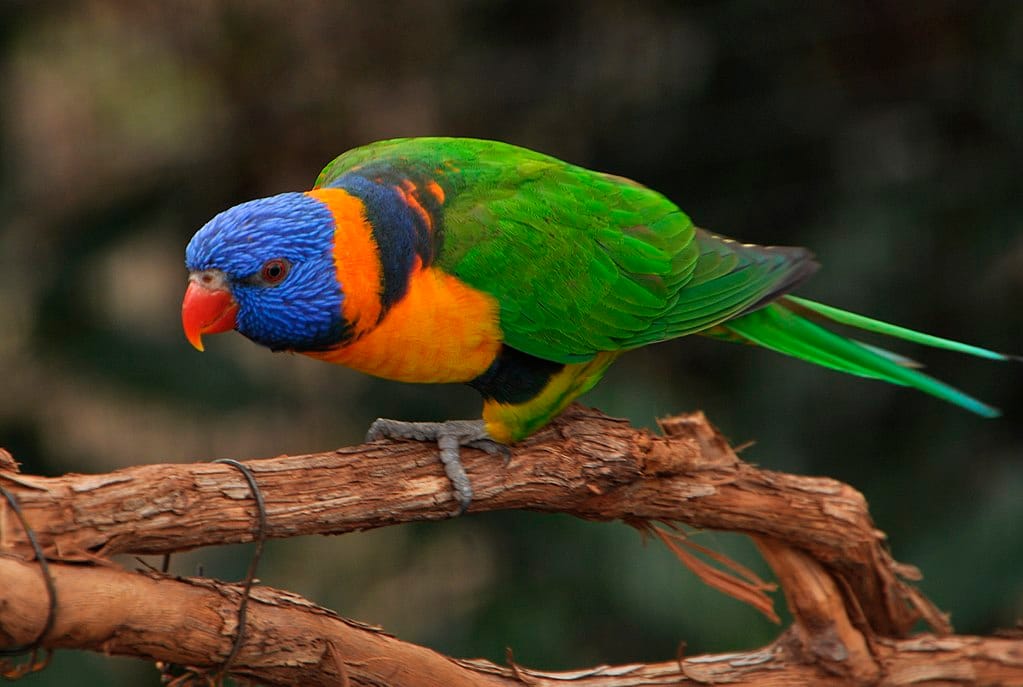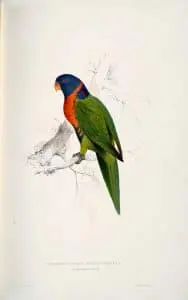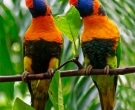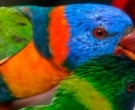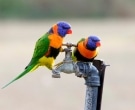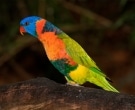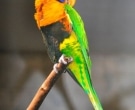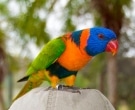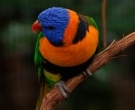26 cm. in length and 103–140 grams in weight.
The Red-collared Lorikee (Trichoglossus rubritorquis) they have the head violet / blue with purple / blue streaks on face; throat and sides of the nape blackish; neck orange / red; chest yellow / orange without sweeping; abdomen dark green; the thighs green / yellow until undertail-coverts; upperparts and tail green; underwing-coverts orange; yellow and broadband under the wing
. Bill orange / red. Eyes dark orange.
The youth they are similar to adults.
taxonomy:
Occasionally he treated in Australian literature as a separate species of Coconut Lorikeet (Trichoglossus haematodus), but this is only appropriate review, as here, the whole complex of Rainbow Lorikeet: differs from Rainbow Lorikeet (Trichoglossus moluccanus) in his collar Orange Fire vs. pale green; Blue neck vs. green; vs belly black. blue; and of the Scarlet-breasted Lorikeet (Trichoglossus forsteni) in his collar Orange Fire vs. yellowish green; nape blue vs. red crab; nape blue vs. dark blue or green; larger size.
Species Monotypic.
- Sound of the Red-collared Lorikee.
Habitat:
There have been no large-scale seasonal movements are common throughout the year in some places.
It's more common in lowlands, but it is up 2400 meters above sea level. They can be observed in a wide variety of areas including settlements, forests, coconut plantations, Savanna, eucalyptus forests and mangroves. They are in mixed flocks with other parrots; small and noisy groups. Nomads, since they depend on flowering trees. It perches communally in groups of hundreds of birds.
Reproduction:
Reproductive biology very similar to that of the Coconut Lorikeet (Trichoglossus haematodus). May-January season in Northern Territory. The laying Typically two or three eggs.
Food:
Diet very similar to the Coconut Lorikeet (Trichoglossus haematodus) which feeds on nectar, fruit, flowers and insects, including Pandanus spiralis. It can also be found around artificial feeding stations.
I necked Lori distribution:
Extension of the distribution (breeding/resident): 1.100.000 km2
North Autóctono Australia, which they inhabit the lowlands. Integrated or hybridized with Coconut Lorikeet (Trichoglossus haematodus) on queensland peninsula, Australia, in southwest Cape York.
Red-collared Lorikeet Conservation:
Rationale for the Red List category
1. Current red list category of the UICN: Least Concern..

2. The population trend: Decreasing.
3. Population size : It is unknown.
This species has a extremely large distribution area, and therefore does not approach the thresholds Vulnerable under the criterion of size range (Extent of Occurrence <20,000 km2 combined with a decreasing area size or fluctuating distribution, extension / habitat quality, or population size and a small number of places or severe fragmentation).
While the trend of the population seems to be decreasing, the decline is not believed to be rapid enough to approach the Vulnerable thresholds according to the population trend criterion (decrease of more than 30% in ten years or three generations).
The population size has not been quantified, but it is not believed to approach the thresholds Vulnerable under the criterion of population size (<10.000 mature individuals with an estimated> 10% continuous decline in ten years or three generations, or with a specific population structure). For these reasons, the species is assessed as Least concern.
Justification of the population
Global population size has not been quantified, but the species is described as abundant (pit et to the. 1997).
Justification trend
It is suspected that the population is declining due to unsustainable levels of exploitation.
Threats
The species has been the subject of a intense trade: from 1981, When it was included in the Appendix II of the CITES, they have been 100.388 individuals caught in international trade (UNEP-WCMC CITES Trade Database, January 2005).
In captivity:
In Europe, this species of lori has been largely imported from early last century, and in 1910 it managed to raise in the zoo London (four years later, the first calf in France). Currently it is rare outside Australia. Life expectancy: 20 years in nature, 15-25 years in captivity.
Alternative names
– Australian rainbow lory, Rainbow Lorikeet (Red-collared), Red collared Lorikeet, Red-collared Lorikeet (English).
– Loriquet à col rouge, Loriquet à collier rouge, Loriquet à tête bleue (à col rouge), Loriquet à tête bleue (rubritorquis) (French).
– Australischer Blauwangenallfarblori, Darwin-Allfarblori, Rotnackenlori (German).
– Periquito-arco-íris (rubritorquis), Lóris-de-colar-rojo (Portuguese).
– Lori cuellirrojo, Lori Arcoiris (rubritorquis) (español).
scientific classification:

– Order: Psittaciformes
– Family: Psittaculidae
– Gender: Trichoglossus
– Scientific name: Trichoglossus rubritorquis
– Subpoena: Vigors & Horsfield, 1827
– Protonimo: Trichoglossus Rubritorquis
Images “Red-collared Lorikee”:
Videos "Red-collared Lorikee"
“Red-collared Lorikee” (Trichoglossus rubritorquis)
-
Sources:
1. Avibase
2. Parrots of the World – Forshaw Joseph M
3. Parrots A Guide to the Parrots of the World – Tony Juniper & Mike Parr
4. Birdlife
Photos:
(1) – A Red-collared Lorikeet at Cincinnati Zoo, Ohio, USA by Fr. Ted Bobosh [CC BY-SA 2.0], via Wikimedia Commons
(2) – A Red-collared Lorikeet at Cincinnati Zoo, Ohio, USA by Ted [CC BY-SA 2.0], via Wikimedia Commons
(3) – Red-collared Lorikeet standing on a man’s cap at Lion Country Safari, Florida, USA by derivative work: Snowmanradio (talk)Trichoglossus_haematodus_rubritorquis_-Lion_Country_Safari-6.jpg: Duncan Rawlinson from Vancouver, BC [CC BY 2.0 or CC BY 2.0], via Wikimedia Commons
(4) – Red-collared Lorikeet (Trichoglossus rubritorquis) in the Walsrode Bird Park, Germany by Quartl [CC BY-SA 3.0], from Wikimedia Commons
(5) – Red-collared Lorikeet (Trichoglossus haemotodius rubritorquis) by Geoff Whalan – Flickr
(6) – Red-collared Lorikeet (Trichoglossus haemotodius rubritorquis) by Geoff Whalan – Flickr
(7) – Red-collared Lorikeet (Trichoglossus haematodus rubritorquis) by Graham Winterflood – Flickr
(8) – Trichoglossus haematodus rubritorquis Location taken: Lion Country Safari, Loxahatchee, Florida Photo by David J. pole [CC BY-SA 4.0], via Wikimedia Commons
(9) – Red-collared Lorikeet (Trichoglossus haemotodius rubritorquis) by Geoff Whalan – Flickr
(10) – A painting of a Red-collared Lorikeet (originally captioned “Trichoglossus rubritorquis. Scarlet-collared Parrakeet by Edward Lear [Public domain]
– Sounds: Phil Gregory, XC287820. accessible www.xeno-canto.org/287820
